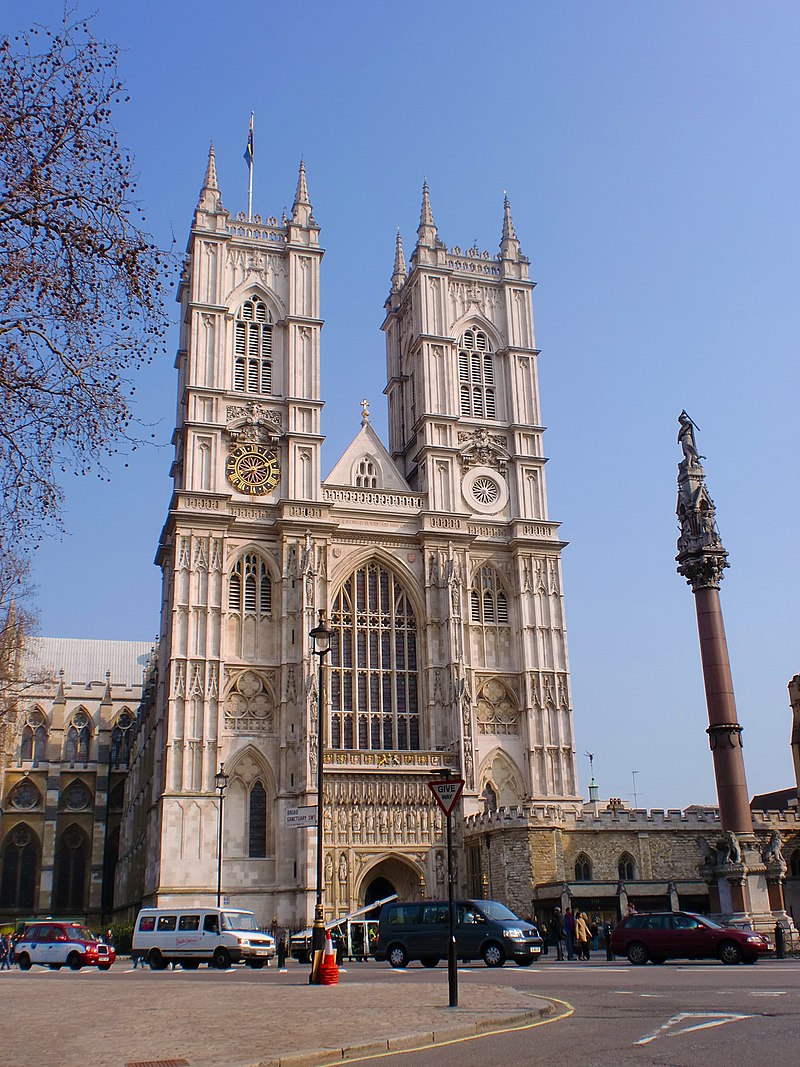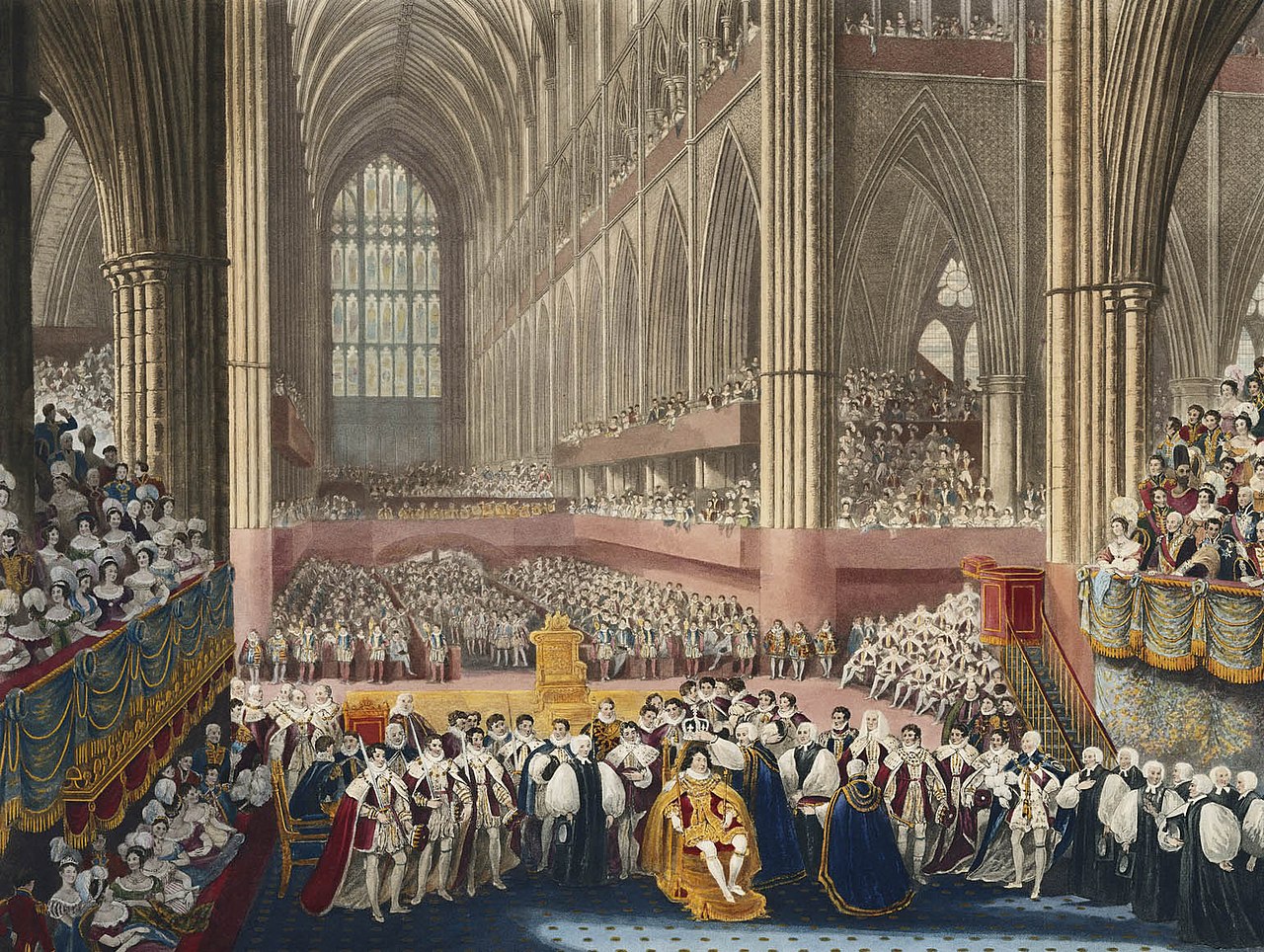by Susan Flantzer
© Unofficial Royalty 2023

Westminster Abbey; Photo Credit – By Σπάρτακος – Own work, CC BY-SA 3.0, https://commons.wikimedia.org/w/index.php?curid=26334184
Check out all our British coronation articles at the link below:
History of Westminster Abbey
First known as St. Peter’s Abbey, Westminster Abbey in London, England was founded by Benedictine monks in 960 under the patronage of King Edgar the Peaceful (reigned 943 – 975) and St. Dunstan, Archbishop of Canterbury. In the 1040s, King Edward, better known as St. Edward the Confessor (reigned 1042 – 1066), built his royal palace nearby St. Peter’s Abbey on the banks of the River Thames on land known as Thorney Island. Later the medieval Palace of Westminster sat upon the site and today the Houses of Parliament (the formal name is still the Palace of Westminster) is there.

A scene from the Bayeux Tapestry showing the funeral procession of Edward the Confessor with the church Edward built on the left. This is the only contemporary depiction of Edward’s church; Credit – Wikipedia
Edward the Confessor began rebuilding St. Peter’s Abbey to provide himself with a royal burial church. This church became known as the “west minster” to distinguish it from (old) St. Paul’s Cathedral (the east minster) in the City of London. See Wikipedia: Minster. The new church was consecrated on December 28, 1065. Too ill to attend the consecration, Edward the Confessor died on January 5, 1066, and was buried before the high altar of his new church the day after his death.
The Shrine of St. Edward the Confessor
In 1245, King Henry III started the construction of the second and present Westminster Abbey in the new Gothic style of architecture. The second church was designed to be not only a place of worship and a monastery but also a place for the coronation and burial of monarchs. This church was consecrated on October 13, 1269, and on that day, King Henry III oversaw a grand ceremony to rebury Edward the Confessor in a magnificent new shrine, directly behind the high altar, and he personally helped to carry the body to its new resting place. Edward the Confessor’s shrine survives and around his shrine were interred five kings and four queens, including King Henry III.
Westminster Abbey has been Britain’s coronation church since 1066. From King William I (the Conqueror) to King Charles III, all monarchs except for two have been crowned in Westminster Abbey. Twelve-year-old King Edward V was presumed murdered in the Tower of London before he could be crowned. King Edward VIII abdicated eleven months after succeeding his father, before his scheduled coronation date.
For more information see Unofficial Royalty: Westminster Abbey in London, England
********************

The Coronation Theatre; Credit – Westminster Abbey
The Coronation Theatre
Like many other Christian churches, Westminster Abbey is built in the shape of a cross. This space where coronations happen is at the point in which the two parts of the cross meet, at the very center of Westminster Abbey, in front of the High Altar

The Cosmati Pavement in front of the High Altar; Credit – By amanderson2 – https://www.flickr.com/photos/49399018@N00/52639897002/, CC BY 2.0, https://commons.wikimedia.org/w/index.php?curid=128111089
The Cosmati Pavement in front of the High Altar was laid down in 1268 during King Henry III’s rebuilding of Westminster Abbey. The mosaic workers came from Rome, with a man called Odoricus as the foreman. The pavement is an inlaid mosaic stone decoration known as Cosmati work, named after one of the Italian families of craftsmen who specialized in it. It is abstract in design and differs from ancient Roman and earlier medieval mosaic work that consisted of square stones of equal size. It is here that the 700-year-old Coronation Chair, also called St. Edward’s Chair and King Edward’s Chair, is placed, facing the High Altar, on which the monarch sits for the majority of the service. Photos from recent coronations show the Cosmati Pavement covered.

The Coronation Theatre at the coronation of Queen Elizabeth II; Credit – By BiblioArchives / LibraryArchives from Canada – Coronation of Queen Elizabeth II / uronnement de la Reine Elizabeth IIUploaded by oaktree_b, CC BY 2.0, https://commons.wikimedia.org/w/index.php?curid=19783528
********************
The Coronation Chair

The Coronation Chair with Stone of Scone in Westminster Abbey, 1885
King Edward I’s relentless, but unsuccessful campaign to assert his overlordship over Scotland was resisted by William Wallace and Robert the Bruce, (later King Robert I of Scotland) but it gave him one of his nicknames, “Hammer of the Scots.” In 1296, Edward I captured the Stone of Scone, an oblong block of red sandstone that was used for centuries in the coronation of the monarchs of Scotland. It was kept at the now-ruined Scone Abbey in Scone, near Perth, Scotland. Edward took the Stone of Scone back to England and placed it in the care of the Abbot of Westminster Abbey.
An oaken chair, called the Coronation Chair, King Edward’s Chair, or St. Edward’s Chair, was made by order of King Edward I to enclose the Stone of Scone. Originally the chair had images of birds, foliage, and animals on a gilt ground. The figure of a king, either Edward the Confessor or King Edward I, his feet resting on a lion, was painted on the back. The four gilt lions on the legs were made in 1727 to replace the original lions which were not added to the chair until the early 16th century. The chair has been in use at coronations since 1308 although opinion is divided as to when it was actually used for the crowning. However, since the coronation of King Henry IV in 1399, the monarch has been crowned in the chair. Originally the Coronation Chair was kept in St. Edward’s Chapel at Westminster Abbey, the site of the shrine of St. Edward the Confessor directly behind the High Altar. The Coronation Chair is now kept in a specially-built enclosure in St. George’s Chapel at the west end of the nave, near the main doors of Westminster Abbey.

The Coronation Chair in its usual home, St. George’s Chapel in Westminster Abbey; Credit – By Darkmaterial – Own work, CC BY-SA 4.0, https://commons.wikimedia.org/w/index.php?curid=127657004
In 1996, 700 years after it was taken, the Stone of Scone was returned to Scotland. It is kept at Edinburgh Castle in the Crown Room alongside the crown jewels of Scotland (the Honours of Scotland). An agreement was made that the Stone of Scone will be returned to Westminster Abbey and placed in the Coronation Chair for future coronations, and then it will be returned to Edinburgh Castle.
********************
Seating Capacity

Some of the tiered seating during the 1821 coronation of King George IV
Westminster Abbey has a seating capacity of 2,200. At the 1953 coronation of Queen Elizabeth II, there were approximately 8,000 guests. Besides the British royal family and other family members, all peers and their wives, all members of the British parliament, representatives from the many nations of the Commonwealth of Nations, heads of state or their representatives, foreign royalty, and members of Parliament from the Queen’s various legislatures, among others, were invited to attend Queen Elizabeth II’s coronation.
A view of some of the tiered seating at the 1953 coronation of Queen Elizabeth II
Westminster Abbey was closed for five months prior to Queen Elizabeth II’s coronation so that the construction needed for 8,000 guests could be completed. Tiered seating, similar to stadium seating, had to be constructed to accommodate all the guests. The coronation of King Charles II in 1661 was the first time that tiered seating was constructed in the transepts so that the congregation could see the ceremony.
The use of tiered seating is no longer possible. Safety regulations at Westminster Abbey now restrict the seating capacity to 2,000 so the guest list was severely limited. Peers were in uproar as only a minority were invited to King Charles III’s coronation.
Before the coronation of King Charles III, Westminster Abbey was closed to visitors from April 25, 2023 – May 7, 2023 for preparations and rehearsals.
This article is the intellectual property of Unofficial Royalty and is NOT TO BE COPIED, EDITED, OR POSTED IN ANY FORM ON ANOTHER WEBSITE under any circumstances. It is permissible to use a link that directs to Unofficial Royalty.
Works Cited
- The Coronation Chair (no date) Westminster Abbey. Available at: https://www.westminster-abbey.org/about-the-abbey/history/the-coronation-chair (Accessed: March 29, 2023).
- Coronation Theatre (no date) Westminster Abbey. Available at: https://www.westminster-abbey.org/about-the-abbey/history/coronations-at-the-abbey/spotlight-on-coronations/coronation-theatre (Accessed: March 29, 2023).
- Cosmati Pavement (no date) Westminster Abbey. Available at: https://www.westminster-abbey.org/about-the-abbey/history/cosmati-pavement (Accessed: March 29, 2023).
- En.wikipedia.org. 2021. List of British coronations – Wikipedia. [online] Available at: <https://en.wikipedia.org/wiki/List_of_British_coronations> (Accessed: March 29, 2023).
- En.wikipedia.org. 2021. Westminster Abbey – Wikipedia. [online] Available at: <https://en.wikipedia.org/wiki/Westminster_Abbey> (Accessed: March 29, 2023).
- Flantzer, Susan. (2021) Westminster Abbey in London, England, Unofficial Royalty. Available at: https://www.unofficialroyalty.com/westminster-abbey-in-london-england/ (Accessed: March 29, 2023).
- Fox, Adam, 1984. Westminster Abbey. Andover: Pitkin Pictorials.
- Jenkyns, Richard, 2005. Westminster Abbey. Cambridge: Harvard University Press.
- Westminster Abbey. 2021. A royal church | Westminster Abbey. [online] Available at: <https://www.westminster-abbey.org/> (Accessed: March 29, 2023).
